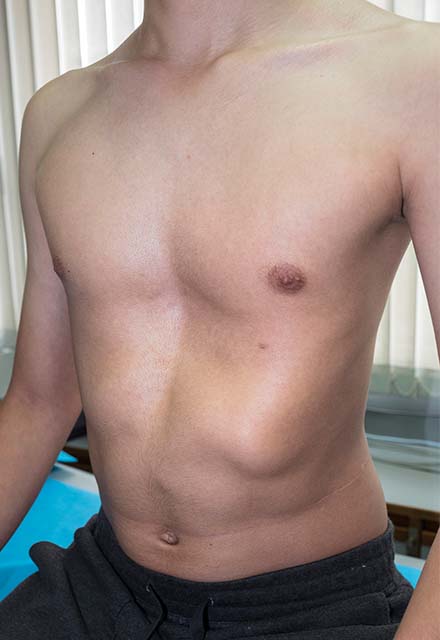Pectus Excavatum Treatment at Johns Hopkins Children's Center
What is pectus excavatum?
Pectus excavatum (PE), translated literally as “hollowed chest” and also referred to as “sunken chest” or “funnel chest,” is the most common chest wall malformation seen in children. An overgrowth of the rib cartilages before and after birth causes the characteristic depression of the sternum (breastbone). Overgrowth commonly accelerates during puberty.
Why choose Johns Hopkins Children Center for pectus excavatum treatment?
The pectus program at Johns Hopkins Children Center comprises one of the most experienced pediatric surgical teams in the country specializing in treatment for chest wall deformities. The pediatric surgery team supports young children and adolescents suffering from these disorders before, during and after correction. Our team is composed of pediatric surgeons, pediatric anesthesiologists, pediatric nurse practitioners, pediatric radiologists and a dedicated post-surgery nursing team.
Johns Hopkins was once the home of Mark Ravitch, who perfected the original open repair of pectus excavatum that bears his name. Johns Hopkins Children Center was also the home of Alex Haller. In 1987, he introduced a radiographically defined pectus excavatum severity score using CT scans. This score is now referred to as the Haller index, and is used worldwide to evaluate pectus patients. Any Haller index score greater than 3.25 is categorized as moderate to severe.
Paul Colombani continued the long tradition of chest wall reconstruction expertise at Johns Hopkins Children’s Center, and modified the minimally invasive repair of PE known as the Nuss procedure. The modifications allowed for improved safety during the procedure and achieved greater stability of the bar. The modified Nuss procedure at Johns Hopkins Children’s Center has allowed for decreased complications and excellent clinical results.
Evaluation
If your child has pectus excavatum and would like it corrected, please schedule an appointment with one of our experienced general pediatric surgeons. During your appointment, your surgeon will spend time reviewing the best correction method for your child.
Causes of Pectus Excavatum
The cause is not known, but often the tendency to develop PE runs in families. Depending on the severity of the malformation, PE may cause:
- Poor posture with slumped shoulders and a protruding abdomen or “pot belly”
- Problems with bone growth and alignment later in life
In severe cases, PE shifts the heart to the left side of the chest and compresses the lungs, limiting the child’s ability to take deep breaths. PE commonly worsens during puberty, until age 18 when most of the growth spurt is complete.
Symptoms
- Young children usually have no symptoms.
- The malformation becomes more pronounced with the growth of the chest during puberty.
- Teenagers complain of shortness of breath with exertion and pain at the front of the chest, and may develop early fatigue.
Diagnosis
 Getty Images
Getty ImagesThe malformation is measured by employing CT scanning to calculate the Haller index.
- The index compares the depth of the chest cavity beneath the sternum to the width of the chest cavity (from right to left).
- Normal ratio of width-to-depth is about 2.5 to 1.
- Any calculation greater than 3.25 is considered a moderate to severe defect.
Treatment
The latest minimally invasive techniques are used to minimize scars, decrease pain and allow a safe procedure with faster recovery rates.
Age
Safe repair of PE is best performed in children over 5 years of age, but the preferred age begins around 14:
- Operation is easier and the recovery is shorter in this age group.
- The majority of the pubertal growth spurt has passed, but the rib bones are still incompletely formed (ossified).
- This allows the chest wall to re-form into a more normal shape as the child grows after the repair.
Older adolescents and adults also report good results with repair.
Nuss Procedure
The operation to repair PE is called a Nuss procedure:
- It involves the placement of one or more stabilizing metal bars just inside the ribcage to move the sternum forward.
- The bars are shaped to the patient during the operation and remain in place for two to three years to allow the ribs to adjust to the new shape of the chest.
Complication rates with the Nuss procedure are exceedingly low and can be discussed in detail with your surgeon.
Cryoablation is used to dramatically reduce pain after surgery. The surgeon will freeze the nerves above and below the bar on each side of the chest. This will temporarily decrease pain transmission through these nerves for three months following surgery. The bars are removed in a separate operation as an outpatient procedure.
Recovery
- Recovery from surgery varies among patients.
- Average length of hospital stay is two to three days.
- Your child’s pain will be well managed by the pediatric pain service.
Pectus Excavatum Q&A
Pectus Excavatum is the most common chest wall deformity seen in children. Pediatric surgeons Samuel Alaish and Clint Cappiello answer common questions about pectus excavatum repair surgery at Johns Hopkins Children's Center.


